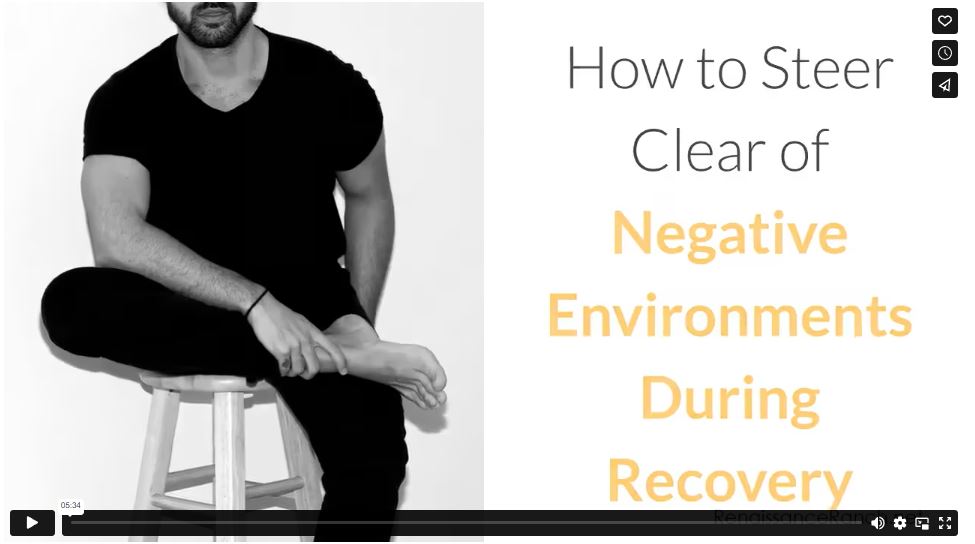When discussing the factors that play into drug and alcohol addiction, biology and environment are the two that often share the top spot. While some of us can point to genetics as one of the many reasons why we may be predisposed to substance abuse, many of us have gotten hooked because of social pressure, previous childhood trauma, or family issues – all environmental stressors.
As the environment is such a dominant causal indicator in addiction, it makes sense that people, dynamics, and physical surroundings can be equally critical in sabotaging or maintaining sobriety. With so much at stake, it’s essential to control your environment as much as possible.

(rudamese / pixabay)
The following are some of the negative environments our substance abuse rehab therapists have come across, and some suggestions on how to manage them:
Childhood Trauma
Abuse, neglect, household dysfunction, and other forms of adverse childhood experiences (ACEs) are leading causes of addiction. Because of stunted growth and development, kids with ACEs tend to develop unhealthy coping mechanisms, including drug and alcohol abuse. These children will likely start drinking and using illicit drugs years earlier than their peers.
While you can’t change the environment in which you grew up, you can choose to face the trauma it has caused in your life. You can start by utilizing individual and group therapy resources in your community to create a safe environment where you can share your feelings and start healing. In addition, consider setting aside time to reflect and complete your therapy assignments. Dealing with the reasons why you drink is as crucial as dealing with your drinking.
Work
It’s no secret that work is a significant stressor for most people. For a person in recovery, the stress can be doubly destructive. You might find yourself in an industry where drug and alcohol abuse is prevalent, such as lodging and foodservice. Or, maybe you’re a lawyer or a salesperson, and it’s expected that you will be consuming alcohol regularly with clients or after hours with your co-workers. You also may have engaged in substance abuse with your co-workers, and now you’re returning to a work situation where you have changed, but they have not.
One obvious solution is to look for a position with a new team and a fresh start. But what happens when this isn’t possible, at least not right away? You have some other options, including cutting down or eliminating time with friends and co-workers who continue to abuse drugs or alcohol.
You can also let your boss know that you don’t drink alcohol anymore. This doesn’t necessarily mean you need to admit you’re in recovery from addiction. People stop drinking for a variety of reasons, including practicing a healthier lifestyle and religious observance. If he or she knows about your new preferences in advance, the next time the subject of alcohol comes up, there will be no need for awkward excuses or questions.
Peers
The peer domain consists of a person’s social groups and the places where they congregate with these groups. Peers who engage in addictive behaviors, particularly within the substance abuse realm, are the largest contributor to a person developing an addiction – even larger than the family domain. On the flip side, peers can be instrumental to addiction recovery through support and motivation.
Digital Distractions
Social media is a double-edged sword. It is a great tool for connecting, but it can also cause tremendous isolation. For example, Instagram, Facebook, and Snapchat only show us the positive aspects of life that the poster wants us to see. This skewed portrayal makes it seem like everyone else is doing fun and amazing things all the time.
The fact is if we allow ourselves to get distracted to the point that all we do is compare ourselves to our social media connections, our self-esteem will tank, and we leave ourselves vulnerable to depression and relapse. However, using social media to connect with others in recovery can lift us by providing a platform to share feelings and insights and coordinate face-to-face activities.
Home
Your home environment can present both physical and emotional challenges. Like it or not, your family relationships have suffered considerably under the burden of your addiction and need healing as much as you do. Without help and training, your family connections will likely continue to be strained and present a considerable barrier to your recovery.
However, by including your family in the recovery process through therapy and addiction education, they can be a great asset to you. Our Renaissance Ranch therapists believe addiction recovery is a family affair. To this end, we offer regular family education webinars and classes, both online and in-person.
The physical environment of your home needs to be safe and comfortable, as well. Dishes overflowing in the sink, stinky garbage, or a consistently dark home can contribute to depression and a sense of hopelessness. It’s much easier to give in to cravings when we are in that dark state of mind.
Your best defense against these types of blahs is to let in the sunlight, tidy up your room or your home, and stock the kitchen with easily accessible healthy food and snacks. That last suggestion is important because people in recovery usually have nutrient deficiencies that contribute to cravings.
If you feel that you need more full-time support, you can look at a residential treatment program like Renaissance Ranch. Our faith-based treatment center outside of Salt Lake City provides a total removal from triggering environments and a fully-structured therapy program to assist you as you work through recovery.
Video

